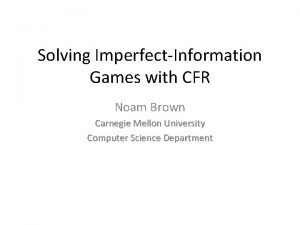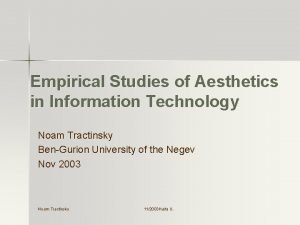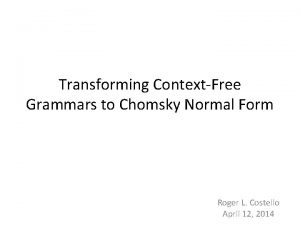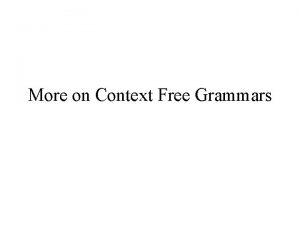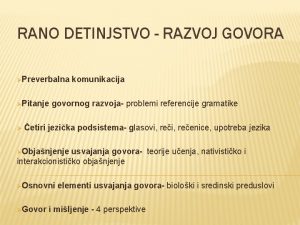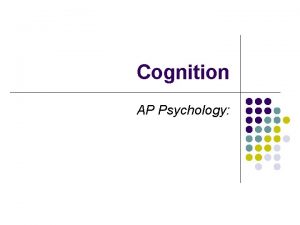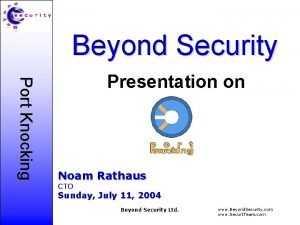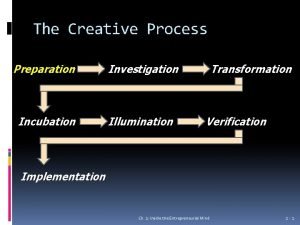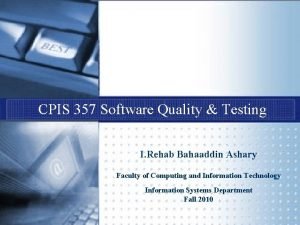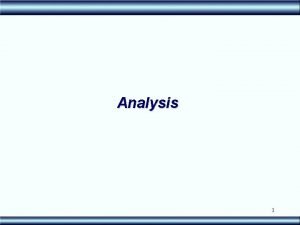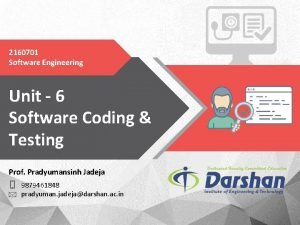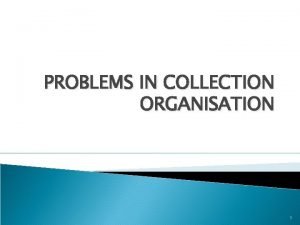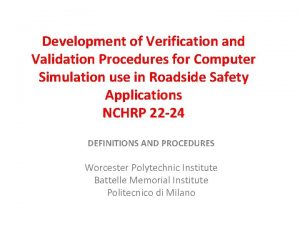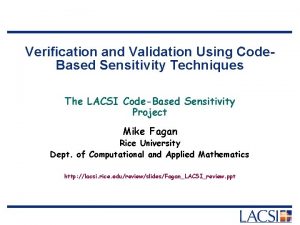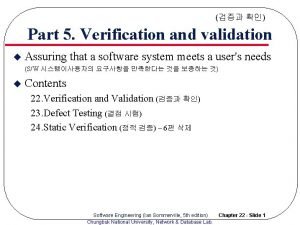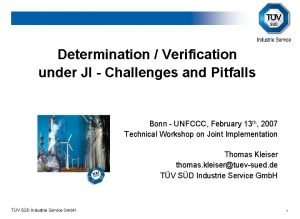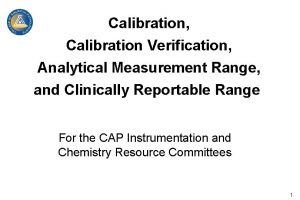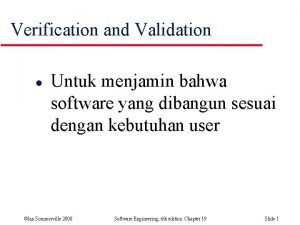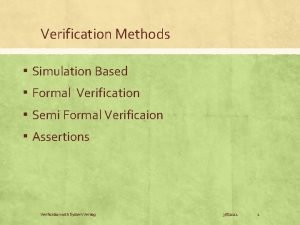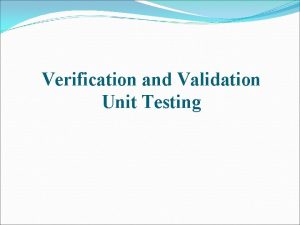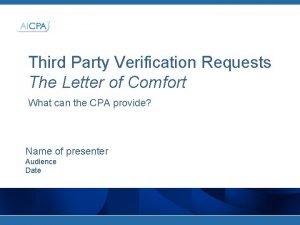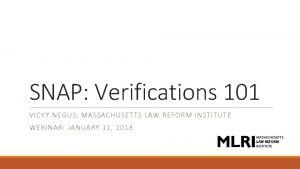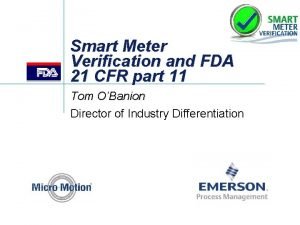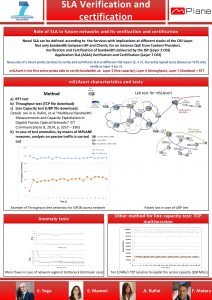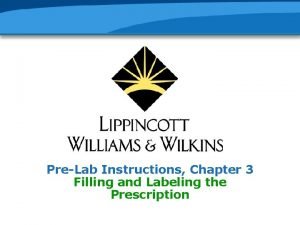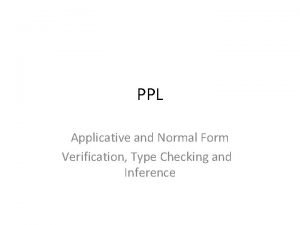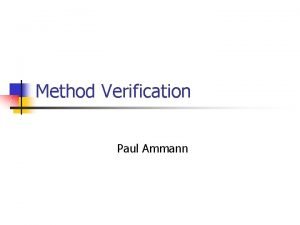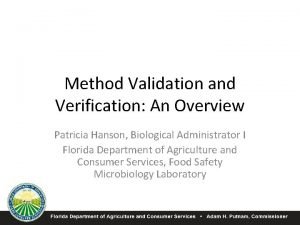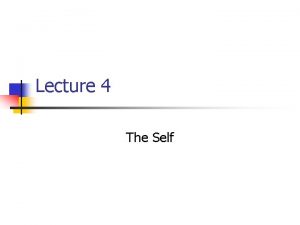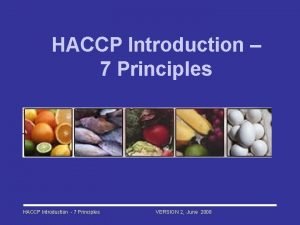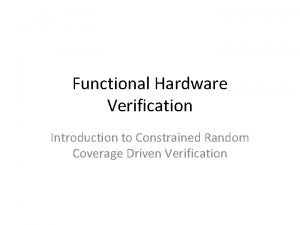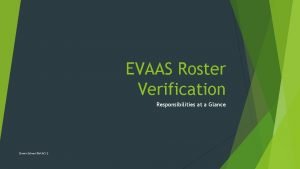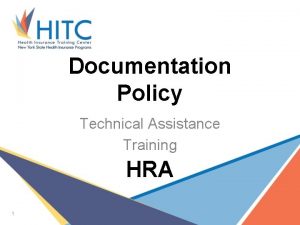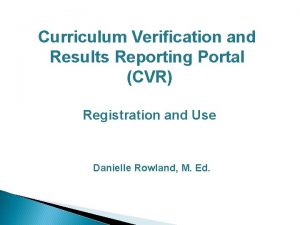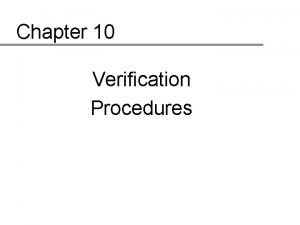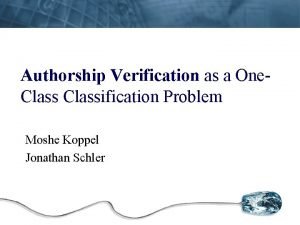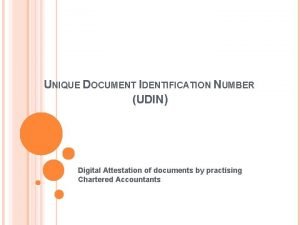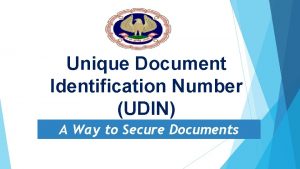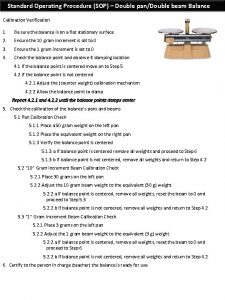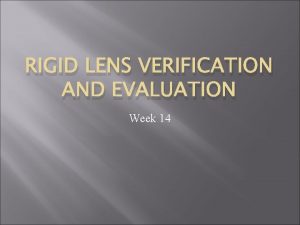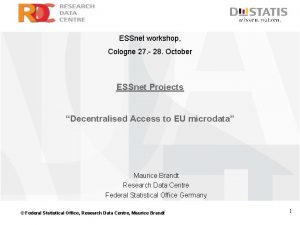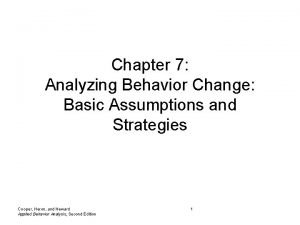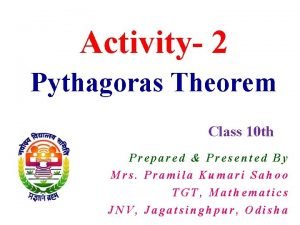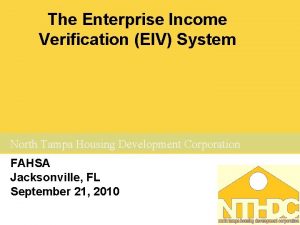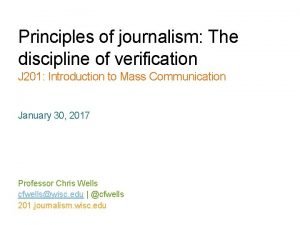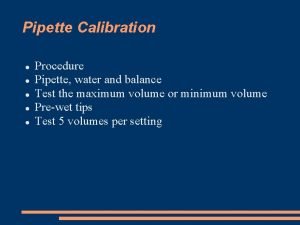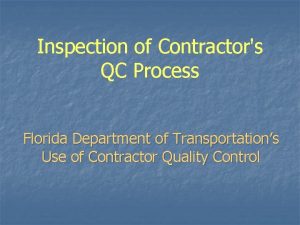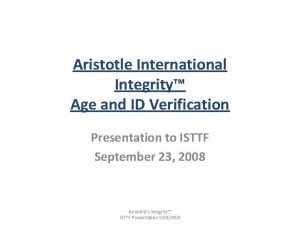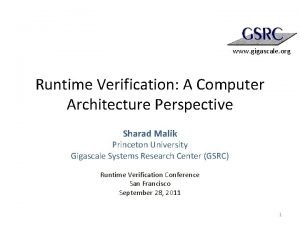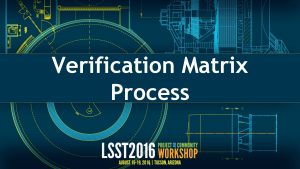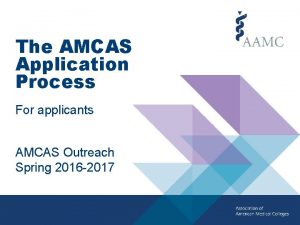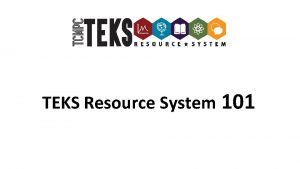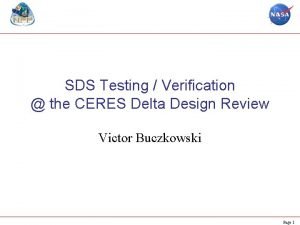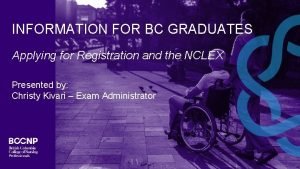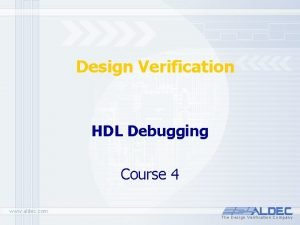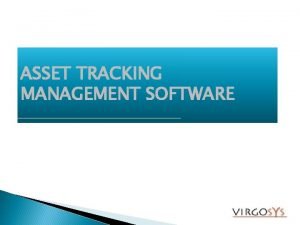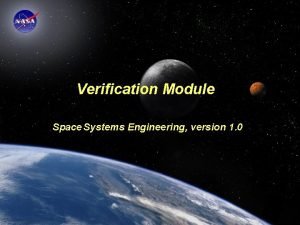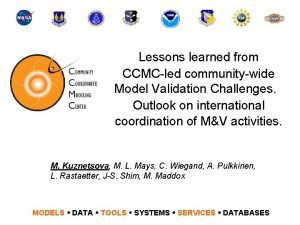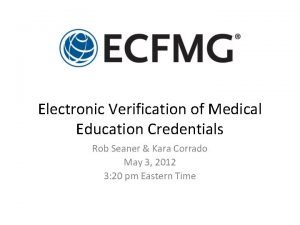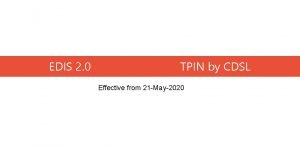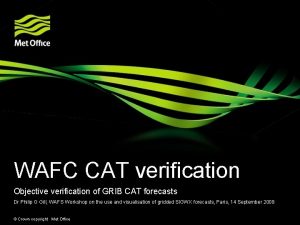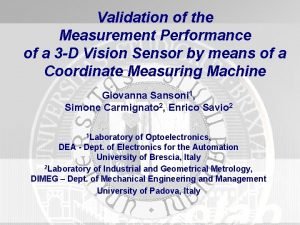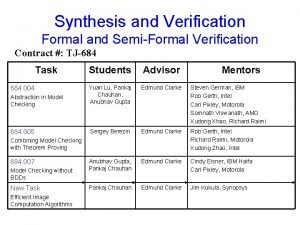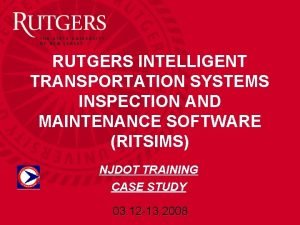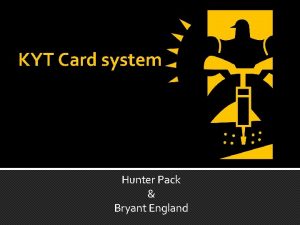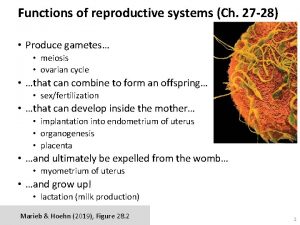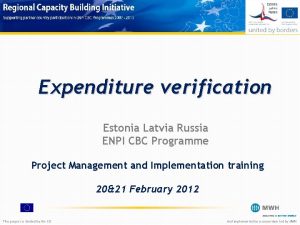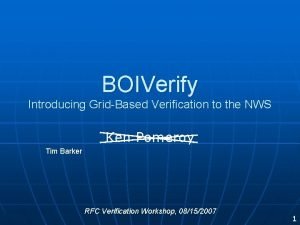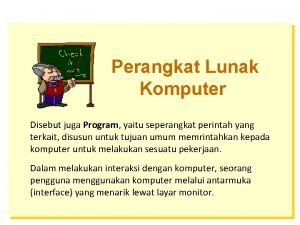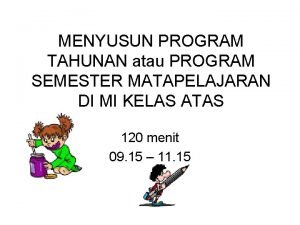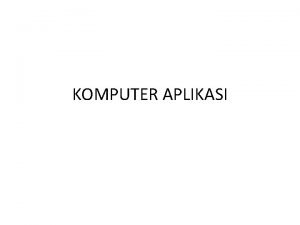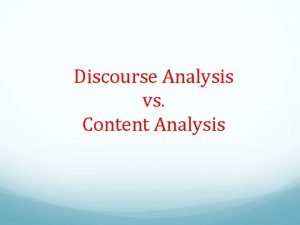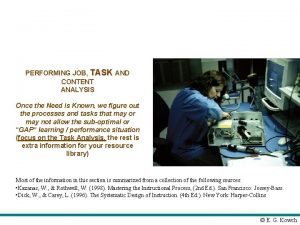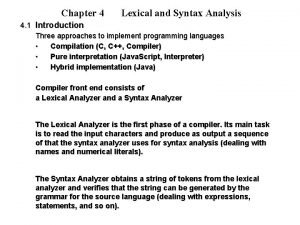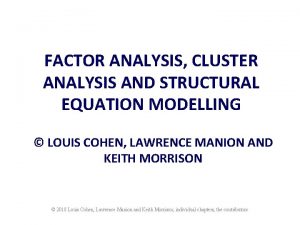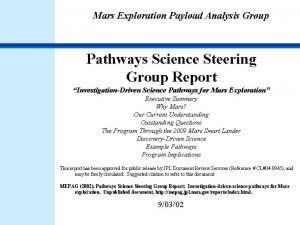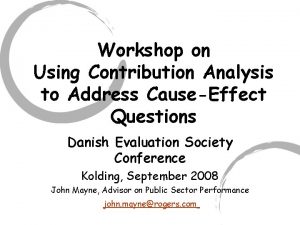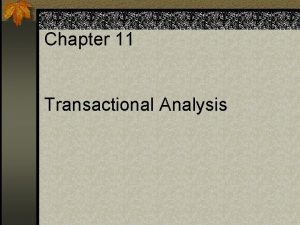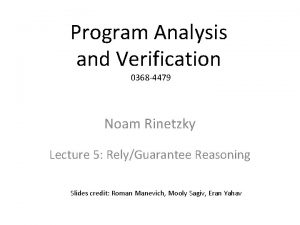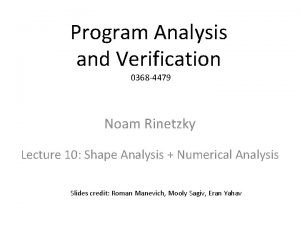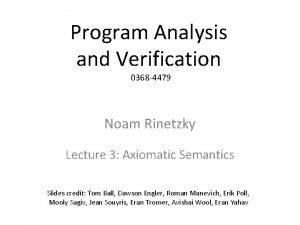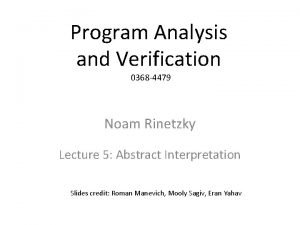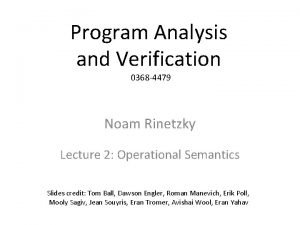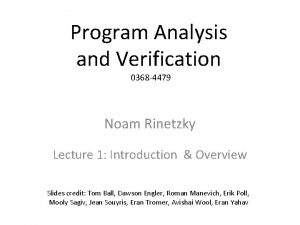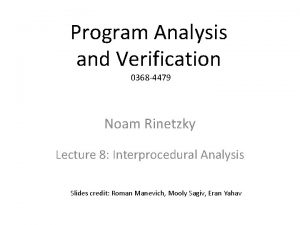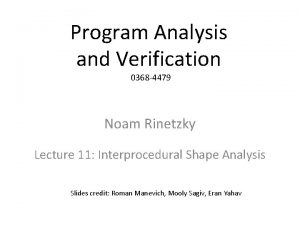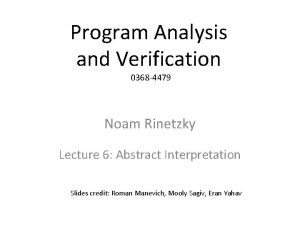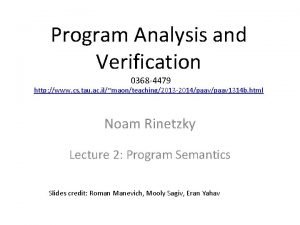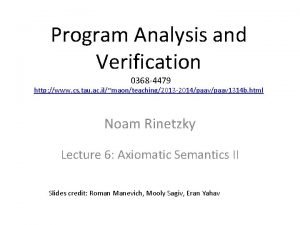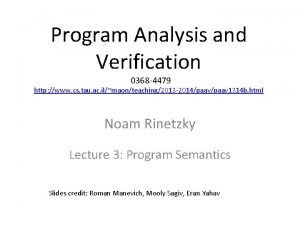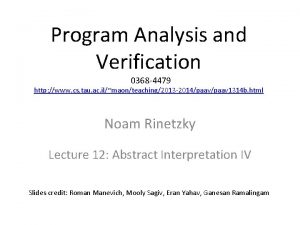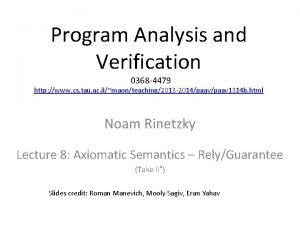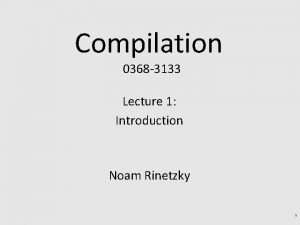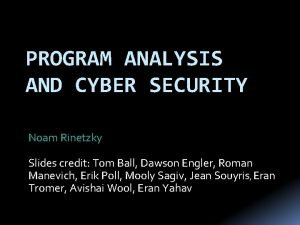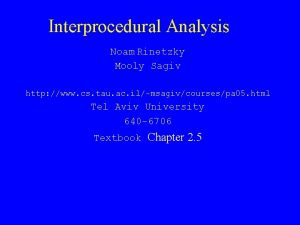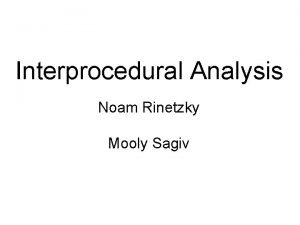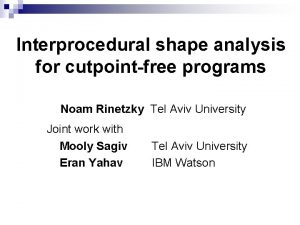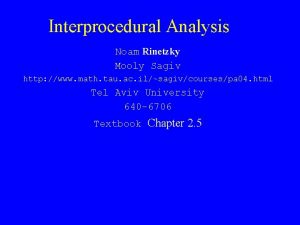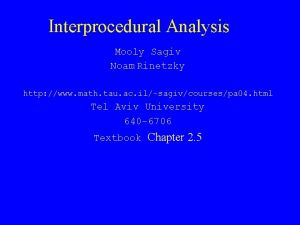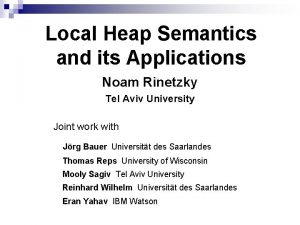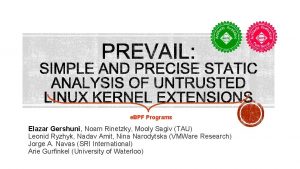Program Analysis and Verification 0368 4479 Noam Rinetzky


















![Windows exploit(s) Buffer Overflow Memory addresses … void foo (char *x) { char buf[2]; Windows exploit(s) Buffer Overflow Memory addresses … void foo (char *x) { char buf[2];](https://slidetodoc.com/presentation_image_h/331b84a5ba6cb330693a02a10a945300/image-19.jpg)
![Buffer overrun exploits int check_authentication(char *password) { int auth_flag = 0; char password_buffer[16]; strcpy(password_buffer, Buffer overrun exploits int check_authentication(char *password) { int auth_flag = 0; char password_buffer[16]; strcpy(password_buffer,](https://slidetodoc.com/presentation_image_h/331b84a5ba6cb330693a02a10a945300/image-20.jpg)






















![L 4. verified [Klein+, ’ 09] • Microkernel – IPC, Threads, Scheduling, Memory management L 4. verified [Klein+, ’ 09] • Microkernel – IPC, Threads, Scheduling, Memory management](https://slidetodoc.com/presentation_image_h/331b84a5ba6cb330693a02a10a945300/image-43.jpg)
















![Intervals Abstraction y y � [3, 6] 6 5 4 3 2 1 0 Intervals Abstraction y y � [3, 6] 6 5 4 3 2 1 0](https://slidetodoc.com/presentation_image_h/331b84a5ba6cb330693a02a10a945300/image-60.jpg)

![Example x � � x=0 x � [0, 0] int x = 0; if Example x � � x=0 x � [0, 0] int x = 0; if](https://slidetodoc.com/presentation_image_h/331b84a5ba6cb330693a02a10a945300/image-62.jpg)












![SLAM (now SDV) [Ball+, ’ 11] • 100 drivers and 80 SLIC rules. – SLAM (now SDV) [Ball+, ’ 11] • 100 drivers and 80 SLIC rules. –](https://slidetodoc.com/presentation_image_h/331b84a5ba6cb330693a02a10a945300/image-75.jpg)





![Find. Bugs [Pugh+, ’ 04] • Analyze Java programs (bytecode) • Looks for “bug Find. Bugs [Pugh+, ’ 04] • Analyze Java programs (bytecode) • Looks for “bug](https://slidetodoc.com/presentation_image_h/331b84a5ba6cb330693a02a10a945300/image-81.jpg)
![PREfix [Pincus+, ’ 00] • Developed by Pinucs, purchased by Microsoft • Automatic analysis PREfix [Pincus+, ’ 00] • Developed by Pinucs, purchased by Microsoft • Automatic analysis](https://slidetodoc.com/presentation_image_h/331b84a5ba6cb330693a02a10a945300/image-82.jpg)

![Coverity [Engler+, ‘ 04] • Looks for bug patterns – Enable/disable interrupts, double locking, Coverity [Engler+, ‘ 04] • Looks for bug patterns – Enable/disable interrupts, double locking,](https://slidetodoc.com/presentation_image_h/331b84a5ba6cb330693a02a10a945300/image-84.jpg)








































![Semantic description methods • Operational semantics – Natural semantics (big step) [G. Kahn] – Semantic description methods • Operational semantics – Natural semantics (big step) [G. Kahn] –](https://slidetodoc.com/presentation_image_h/331b84a5ba6cb330693a02a10a945300/image-125.jpg)






![Example state manipulations • • • [x 1, y 7, z 16] y = Example state manipulations • • • [x 1, y 7, z 16] y =](https://slidetodoc.com/presentation_image_h/331b84a5ba6cb330693a02a10a945300/image-132.jpg)





- Slides: 137

Program Analysis and Verification 0368 -4479 Noam Rinetzky Lecture 1: Introduction & Overview Slides credit: Tom Ball, Dawson Engler, Roman Manevich, Erik Poll, Mooly Sagiv, Jean Souyris, Eran Tromer, Avishai Wool, Eran Yahav

Admin • Lecturer: Noam Rinetzky – maon@cs. tau. ac. il – http: //www. cs. tau. ac. il/~maon • 13 Lessons – Thursday, 13: 00 -16: 00, Dan David 2

Grades • 2 -3 theoretical assignments (35%) • 1 practical assignment (15%) • Final project (50%) – In groups of 1 -2 3

Today • Motivation • Introduction 4

Software is Everywhere

Software is Everywhere Unreliable


30 GB Zunes all over the world fail en masse December 31, 2008 8

Zune bug 1 while (days > 365) { 2 if (Is. Leap. Year(year)) { 3 if (days > 366) { 4 days -= 366; 5 year += 1; 6 } 7 } else { 8 days -= 365; 9 year += 1; 10 } 11 } December 31, 2008 9

Zune bug 1 while (366 > 365) { 2 if (Is. Leap. Year(2008)) { 3 if (366 > 366) { 4 days -= 366; 5 year += 1; 6 } 7 } else { 8 days -= 365; 9 year += 1; 10 } 11 } December 31, 2008 Suggested solution: wait for tomorrow 10

Patriot missile failure On the night of the 25 th of February, 1991, a Patriot missile system operating in Dhahran, Saudi Arabia, failed to track and intercept an incoming Scud. The Iraqi missile impacted into an army barracks, killing 28 U. S. soldiers and injuring another 98. February 25, 1991 11

Patriot bug – rounding error • Time measured in 1/10 seconds • Binary expansion of 1/10: 0. 0001100110011001100. . • 24 -bit register 0. 000110011001100 • error of – 0. 0000000000001100. . . binary, or ~0. 000000095 decimal • After 100 hours of operation error is 0. 000000095× 100× 3600× 10=0. 34 • A Scud travels at about 1, 676 meters per second, and so travels more than half a kilometer in this time Suggested solution: reboot every 10 hours 12

Toyota recalls 160, 000 Prius hybrid vehicles Programming error can activate all warning lights, causing the car to think its engine has failed October 2005

Therac-25 leads to 3 deaths and 3 injuries Software error exposes patients to radiation overdose (100 X of intended dose) 1985 to 1987

Northeast Blackout 14 August, 2003

Northeast Blackout A race condition stalled First. Energy's control room alarm • system for over 1 HOUR, depriving operators from both audio and visual alerts Unprocessed events queued up and the primary server failed • within 30 minutes All applications (including the alarm system) automatically • transferred to the backup server, which itself failed The server failed, slowing screen refresh rate of the operators' • computer consoles from 1– 3 seconds to 59 seconds per screen, leading operators to dismiss a call from American Electric Power about the problem Technical support informed control room personnel of the • alarm system failure 50 MINUTES after the backup failed Bottom line: at least 11 deaths and $6 billion damages 14 August, 2003

Unreliable Software is Exploitable An : h c a bre k r nza o a w n t o e ft b n N e o i h ts. R SA' t t a u RSA h t y p t S i h y t s c a n l c a e P o e acked d r r i y porat d a b u on t a S a , info r f e d e f h n n o T e o i k t t s w i a descr ) ork su rmation Stuxnet Worm S ti St r r 1 y e 1 a h 0 l g i 2 P leaks i b ll ffered es as hontrol a(At p. Irrailn ny Opult eo af t. C p o e S r a e 's s what succe istent iv in form peuoclear Sites, E RSA Mass million N s t s h f a r u x p e t e rt l i s a o S a a y t n d 7 a " was ut 7 stole ttack, and vanced abo The Stuxnet worm affect n rtohb ata tcan "certain , named after initia c tdh e. A s some ls found in its code, is n a e c r ho o u t e the most sophisti r cated dobe Read n attacker ity of Sec w cyberweapon eve tahuisthen ur. ID w a r, A t e o l a y l r ch h a re a t l a te d y h tication ports a Fl(a. M las P po. tentiall s e F r e e b r ar ch 2 re a via Ado rash and e s r h k o il T 011) c f a. a y t r m t c m e o a (D e e a s c t e i m n d s b v e a e r y 2 s 0 t d 1 s s 0 u ) e d a arg toke ted ity A d ca rs em ehnint. e n v m i ay l h b e Secur bility coul f the affec he wild in t Rf. SA c e d) major i slee dcu atta a o t ) 1 n r e l tw s 1 e o n l rk o i 0 x n r. l ri t ty probleam u h 2 el ( on ited This v (M rcs at Lockheed take c eing explo crosoft Exc Mi is b Martin a y t i n l i i Lo b d ck h e a e e d r M ar d ti e n r d emote access network vuln ile embe , p f ro te ct ) e d f b y Se cu w r. I D s t okens, has been (. shut down (May 2011)

Billy Gates why do you make this possible ? Stop making money and fix your software!! (W 32. Blaster. Worm) August 13, 2003 18
![Windows exploits Buffer Overflow Memory addresses void foo char x char buf2 Windows exploit(s) Buffer Overflow Memory addresses … void foo (char *x) { char buf[2];](https://slidetodoc.com/presentation_image_h/331b84a5ba6cb330693a02a10a945300/image-19.jpg)
Windows exploit(s) Buffer Overflow Memory addresses … void foo (char *x) { char buf[2]; strcpy(buf, x); } int main (int argc, char *argv[]) { foo(argv[1]); } Previous frame br Return address da Saved FP ca char* x ra . /a. out abracadabra Segmentation fault buf[2] ab Stack grows this way 19
![Buffer overrun exploits int checkauthenticationchar password int authflag 0 char passwordbuffer16 strcpypasswordbuffer Buffer overrun exploits int check_authentication(char *password) { int auth_flag = 0; char password_buffer[16]; strcpy(password_buffer,](https://slidetodoc.com/presentation_image_h/331b84a5ba6cb330693a02a10a945300/image-20.jpg)
Buffer overrun exploits int check_authentication(char *password) { int auth_flag = 0; char password_buffer[16]; strcpy(password_buffer, password); if(strcmp(password_buffer, "brillig") == 0) auth_flag = 1; if(strcmp(password_buffer, "outgrabe") == 0) auth_flag = 1; return auth_flag; } int main(int argc, char *argv[]) { if(check_authentication(argv[1])) { printf("n-=-=-=-=-=-=-=-n"); printf(" Access Granted. n"); printf("-=-=-=-=-=-=-=-n"); } else printf("n. Access Denied. n"); } (source: “hacking – the art of exploitation, 2 nd Ed”) 20

Input Validation evil input Application 1234567890123456 -=-=-=-=-=-=-= Access Granted. -=-=-=-=-=-=-=-

Boeing's 787 Vulnerable to Hacker Attack security vulnerability in onboard computer networks could allow passengers to access the plane's control systems January 2008

Apple's SSL/TLS bug (22 Feb 2014) • Affects i. OS (probably OSX too) static OSStatus SSLVerify. Signed. Server. Key. Exchange(…) { OSStatus err; . . . if ((err = SSLHash. SHA 1. f 1(. . . )) != 0) goto fail; if ((err = SSLHash. SHA 1. f 2(. . . )) != 0) goto fail; if ((err = SSLHash. SHA 1. f 3(. . . )) != 0) goto fail; . . . fail: SSLFree. Buffer(&signed. Hashes); SSLFree. Buffer(&hash. Ctx); return err; } (Quoted from http: //opensource. apple. com/source/Security-55471/libsecurity_ssl/lib/ssl. Key. Exchange. c )

Shellshock bug (24/Sep/2014) • Affects Linux & OSX • 22 years old bug! 30 Sep 2014 GNU Bash through 4. 3 processes trailing strings after function definitions in the values of environment variables, which allows remote attackers to execute arbitrary code via a crafted environment

What can we do about it?

What can we do about it? I just want to say LOVE YOU SAN!!soo much Billy Gates why do you make this possible ? Stop making money and fix your software!! (W 32. Blaster. Worm / Lovesan worm) August 13, 2003 26

What can we do about it? • • • Monitoring Testing Static Analysis Formal Verification Specification Run time Design Time

Monitoring (e. g. , for security) monitored application (Outlook) user space monitor open(“/etc/passwd”, “r”) OS Kernel • • Stack. Guard Pro. Police Point. Guard Security monitors (ptrace)

Testing • build it

Testing • build it; try it on a some inputs – printf (“x == 0 => should not get that!”)

Testing • Valgrind memory errors, race conditions, taint analysis – Simulated CPU – Shadow memory Invalid read of size 4 at 0 x 40 F 6 BBCC: (within /usr/libpng. so. 2. 1. 0. 9) by 0 x 40 F 6 B 804: (within /usr/libpng. so. 2. 1. 0. 9) by 0 x 40 B 07 FF 4: read_png_image(QImage. IO *) (kernel/qpngio. cpp: 326) by 0 x 40 AC 751 B: QImage. IO: : read() (kernel/qimage. cpp: 3621) Address 0 x. BFFFF 0 E 0 is not stack'd, malloc'd or free'd

Testing • Valgrind memory errors, race conditions • Parasoft Jtest/Insure++ memory errors + visualizer, race conditions, exceptions … • IBM Rational Purify memory errors • IBM Pure. Coverage detect untested paths • Daikon dynamic invariant detection

Testing • Useful and challenging – Random inputs – Guided testing (coverage) – Bug reproducing • But … – Observe some program behaviors – What can you say about other behaviors?

Testing is not enough • Observe some program behaviors • What can you say about other behaviors? • Concurrency makes things worse • Smart testing is useful – requires the techniques that we will see in the course 34

What can we do about it? • • • Monitoring Testing Static Analysis Formal Verification Specification Run time Design Time

Program Analysis & Verification x = ? if (x > 0) { y = 42; } else { y = 73; foo(); } assert (y == 42); ? Is assertion true? 36

Program Analysis & Verification y = ? ; x = y * 2 if (x % 2 == 0) { y = 42; } else { y = 73; foo(); } assert (y == 42); ? Is assertion true? Can we prove this? Automatically? Bad news: problem is generally undecidable 37

Formal verification • Mathematical model of software – : Var Z – = [x 0, y 1] • Logical specification – { 0 < x } = { ∈ State | 0 < (x) } • Machine checked formal proofs { 0 < x ∧ y = x } → { 0 < y } } y: = x { 0 < x ∧ y = x } { 0 < y } y: = y+1 { 1< y } { 0 < x 1 < y } { { 0 < x } y: = x ; y: =y+1 { ? }

Formal verification • Mathematical model of software – State = Var Integer – S = [x 0, y 1] • Logical specification – { 0 < x } = { S ε State | 0 < S(x) } • Machine checked formal proofs Q’ → P’ { P’ } stmt 2 { Q } { P } stmt 1 { Q’ } { P } stmt 1; stmt 2 { Q }

Program Verification {true} y = ? ; x = 2 * y; {x = 2 * y} if (x % 2 == 0) { {x = 2 * y} y = 42; { z. x = 2 * z∧ y = 42 } } else { { false } y = 73; foo(); { false } } { z. x = 2 * z∧ y = 42 } assert (y == 42); E E Is assertion true? Can we prove this? Automatically? Can we prove this manually? 40

Central idea: use approximation Over Approximation Exact set of configurations/ behaviors Under Approximation universe 41

Program Verification {true} y = ? ; x = 2 * y; {x = 2 * y} if (x % 2 == 0) { {x = 2 * y} y = 42; { z. x = 2 * z∧ y = 42 } } else { { false } y = 73; foo(); { false } } { z. x = 2 * z∧ y = 42 } {x = ? ∧ y = 42 } { x = 4∧ y = 42 } assert (y == 42); E E Is assertion true? Can we prove this? Automatically? Can we prove this manually? 42
![L 4 verified Klein 09 Microkernel IPC Threads Scheduling Memory management L 4. verified [Klein+, ’ 09] • Microkernel – IPC, Threads, Scheduling, Memory management](https://slidetodoc.com/presentation_image_h/331b84a5ba6cb330693a02a10a945300/image-43.jpg)
L 4. verified [Klein+, ’ 09] • Microkernel – IPC, Threads, Scheduling, Memory management • Functional correctness (using Isabelle/HOL) + + + No null pointer de-references. No memory leaks. No buffer overflows. No unchecked user arguments … • Kernel/proof co-design – Implementation - 2. 5 py (8, 700 LOC) – Proof – 20 py (200, 000 LOP)

Static Analysis • Lightweight formal verification • Formalize software behavior in a mathematical model (semantics) • Prove (selected) properties of the mathematical model – Automatically, typically with approximation of the formal semantics

Why static analysis? • Some errors are hard to find by testing – arise in unusual circumstances/uncommon execution paths • buffer overruns, unvalidated input, exceptions, . . . – involve non-determinism • race conditions • Full-blown formal verification too expensive

Is it at all doable? x = ? if (x > 0) { y = 42; } else { y = 73; foo(); } assert (y == 42); Bad news: problem is generally undecidable 46

Central idea: use approximation Over Approximation Exact set of configurations/ behaviors Under Approximation universe 47

Goal: exploring program states bad states reachable states initial states 48

Technique: explore abstract states bad states reachable states initial states 49

Technique: explore abstract states bad states reachable states initial states 50

Technique: explore abstract states bad states reachable states initial states 51

Technique: explore abstract states bad states reachable states initial states 52

Sound: cover all reachable states bad states reachable states initial states 53

Unsound: miss some reachable states bad states reachable states initial states 54

Imprecise abstraction False alarms bad states reachable states initial states 55 55

A sound message x = ? if (x > 0) { y = 42; } else { y = 73; foo(); } assert (y == 42); Assertion may be violated 56

Precision • Avoid useless result Useless. Analysis(Program p) { printf(“assertion may be violatedn”); } • Low false alarm rate • Understand where precision is lost 57

A sound message y = ? ; x = y * 2 if (x % 2 == 0) { y = 42; } else { y = 73; foo(); } assert (y == 42); Assertion is true 58

How to find “the right” abstraction? • Pick an abstract domain suited for your property – Numerical domains – Domains for reasoning about the heap –… • Combination of abstract domains 59
![Intervals Abstraction y y 3 6 6 5 4 3 2 1 0 Intervals Abstraction y y � [3, 6] 6 5 4 3 2 1 0](https://slidetodoc.com/presentation_image_h/331b84a5ba6cb330693a02a10a945300/image-60.jpg)
Intervals Abstraction y y � [3, 6] 6 5 4 3 2 1 0 1 2 3 4 x x � [1, 4] 60

![Example x x0 x 0 0 int x 0 if Example x � � x=0 x � [0, 0] int x = 0; if](https://slidetodoc.com/presentation_image_h/331b84a5ba6cb330693a02a10a945300/image-62.jpg)
Example x � � x=0 x � [0, 0] int x = 0; if (? ) x++; if x � [0, 0] x � [0, 1] x++ x � [1, 2] if x � [0, 2] exit [a 1, a 2] � [b 1, b 2] = [min(a 1, b 1), max(a 2, b 2)] 62

Polyhedral Abstraction • abstract state is an intersection of linear inequalities of the form a 1 x 2+a 2 x 2+…anxn � c • represent a set of points by their convex hull (image from http: //www. cs. sunysb. edu/~algorith/files/convex-hull. shtml) 63

Mc. Carthy 91 function 64

Mc. Carthy 91 function proc MC (n : int) returns (r : int) var t 1 : int, t 2 : int; begin if n > 100 then r = n - 10; else t 1 = n + 11; t 2 = MC(t 1); r = MC(t 2); endif; end var a : int, b : int; begin /* top */ b = MC(a); end if (n>=101) then n-10 else 91 65

Mc. Carthy 91 function proc MC (n : int) returns (r : int) var t 1 : int, t 2 : int; if (n>=101) then n-10 else 91 begin /* top */ if n > 100 then /* [|n-101>=0|] */ r = n - 10; /* [|-n+r+10=0; n-101>=0|] */ else /* [|-n+100>=0|] */ t 1 = n + 11; /* [|-n+t 1 -11=0; -n+100>=0|] */ t 2 = MC(t 1); /* [|-n+t 1 -11=0; -n+100>=0; -n+t 2 -1>=0; t 2 -91>=0|] */ r = MC(t 2); /* [|-n+t 1 -11=0; -n+100>=0; -n+t 2 -1>=0; t 2 -91>=0; r-t 2+10>=0; r-91>=0|] */ endif; /* [|-n+r+10>=0; r-91>=0|] */ end var a : int, b : int; begin /* top */ b = MC(a); /* [|-a+b+10>=0; b-91>=0|] */ end if (n>=101) then n-10 else 91 66

Mc. Carthy 91 function proc MC (n : int) returns (r : int) var t 1 : int, t 2 : int; begin /* (L 6 C 5) top */ if n > 100 then /* (L 7 C 17) [|n-101>=0|] */ r = n - 10; /* (L 8 C 14) [|-n+r+10=0; n-101>=0|] */ else /* (L 9 C 6) [|-n+100>=0|] */ t 1 = n + 11; /* (L 10 C 17) [|-n+t 1 -11=0; -n+100>=0|] */ t 2 = MC(t 1); /* (L 11 C 17) [|-n+t 1 -11=0; -n+100>=0; -n+t 2 -1>=0; t 2 -91>=0|] */ r = MC(t 2); /* (L 12 C 16) [|-n+t 1 -11=0; -n+100>=0; -n+t 2 -1>=0; t 2 -91>=0; r-t 2+10>=0; r-91>=0|] */ endif; /* (L 13 C 8) [|-n+r+10>=0; r-91>=0|] */ end if (n>=101) then n-10 else 91 var a : int, b : int; begin /* (L 18 C 5) top */ b = MC(a); /* (L 19 C 12) [|-a+b+10>=0; b-91>=0|] */ end 67

What is Static analysis Develop theory and tools for program correctness and robustness Reason statically (at compile time) about the possible runtime behaviors of a program “The algorithmic discovery of properties of a program by inspection of its source text 1” -- Manna, Pnueli 1 Does not have to literally be the source text, just means w/o running it 68

Static analysis definition Reason statically (at compile time) about the possible runtime behaviors of a program “The algorithmic discovery of properties of a program by inspection of its source text 1” -- Manna, Pnueli 1 Does not have to literally be the source text, just means w/o running it 69

Some automatic tools 70

Challenges class Socket. Holder { Socket s; } Socket make. Socket() { return new Socket(); // A } open(Socket l) { l. connect(); } talk(Socket s) { s. get. Output. Stream()). write(“hello”); } main() { Set<Socket. Holder> set = new Hash. Set<Socket. Holder>(); while(…) { Socket. Holder h = new Socket. Holder(); h. s = make. Socket(); set. add(h); } for (Iterator<Socket. Holder> it = set. iterator(); …) { Socket g = it. next(). s; open(g); talk(g); } } 71

(In)correct usage of APIs Application trend: Increasing number of libraries and APIs – Non-trivial restrictions on permitted sequences of operations Typestate: Temporal safety properties – What sequence of operations are permitted on an object? – Encoded as DFA e. g. “Don’t use a Socket unless it is connected” close() get. Input. Stream() get. Output. Stream() init connect() get. Input. Stream() get. Output. Stream() connected close() closed get. Input. Stream() get. Output. Stream() err * 72

Static Driver Verifier Rules Static Driver Verifier Precise API Usage Rules (SLIC) Defects 100% path coverage Driver’s Source Code in C Environment model

SLAM Locking rule in SLIC State machine for locking Rel Unlocked Acq Rel Locked Acq Error state { enum {Locked, Unlocked} s = Unlocked; } Ke. Acquire. Spin. Lock. entry { if (s==Locked) abort; else s = Locked; } Ke. Release. Spin. Lock. entry { if (s==Unlocked) abort; else s = Unlocked; }
![SLAM now SDV Ball 11 100 drivers and 80 SLIC rules SLAM (now SDV) [Ball+, ’ 11] • 100 drivers and 80 SLIC rules. –](https://slidetodoc.com/presentation_image_h/331b84a5ba6cb330693a02a10a945300/image-75.jpg)
SLAM (now SDV) [Ball+, ’ 11] • 100 drivers and 80 SLIC rules. – The largest driver ~ 30, 000 LOC – Total size ~450, 000 LOC • The total runtime for the 8, 000 runs (driver x rule) – 30 hours on an 8 -core machine – 20 mins. Timeout • Useful results (bug / pass) on over 97% of the runs • Caveats: pointers (imprecise) & concurrency (ignores)

The Astrée Static Analyzer Patrick Cousot Radhia Cousot Jérôme Feret Laurent Mauborgne Antoine Miné Xavier Rival ENS France

Objectives of Astrée • Prove absence of errors in safety critical C code • ASTRÉE was able to prove completely automatically the absence of any RTE in the primary flight control software of the Airbus A 340 fly-by-wire system – a program of 132, 000 lines of C analyzed By Lasse Fuss (Own work) [CC-BY-SA-3. 0 (http: //creativecommons. org/licenses/by-sa/3. 0)], via Wikimedia Commons

Scaling false positives bad states reachable states false negatives initial states Sound Complete 78

Unsound static analysis false positives bad states reachable states false negatives initial states 79

Unsound static analysis • Static analysis – No code execution • Trade soundness for scalability – Do not cover all execution paths – But cover “many”
![Find Bugs Pugh 04 Analyze Java programs bytecode Looks for bug Find. Bugs [Pugh+, ’ 04] • Analyze Java programs (bytecode) • Looks for “bug](https://slidetodoc.com/presentation_image_h/331b84a5ba6cb330693a02a10a945300/image-81.jpg)
Find. Bugs [Pugh+, ’ 04] • Analyze Java programs (bytecode) • Looks for “bug patterns” • Bug patterns – Method() vs method() – Override equal(…) but not hash. Code() – Unchecked return values – Null pointer dereference App 17 KLOC NP bugs Other Bugs Bad Practice Dodgy Sun JDK 1. 7 597 68 180 594 654 Eclipse 3. 3 1447 146 259 1079 653 Netbeans 6 1022 189 305 3010 1112 glassfish 2176 146 154 964 1222 jboss 178 30 57 263 214
![PREfix Pincus 00 Developed by Pinucs purchased by Microsoft Automatic analysis PREfix [Pincus+, ’ 00] • Developed by Pinucs, purchased by Microsoft • Automatic analysis](https://slidetodoc.com/presentation_image_h/331b84a5ba6cb330693a02a10a945300/image-82.jpg)
PREfix [Pincus+, ’ 00] • Developed by Pinucs, purchased by Microsoft • Automatic analysis of C/C++ code – Memory errors, divide by zero – Inter-procedural bottom-up analysis – Heuristic - choose “ 100” paths – Minimize effect of false positive Program KLOC Time Mozilla browser 540 11 h Apache 49 15 m 2 -5 warnings per KLOC

PREfast • Analyze Microsoft kernel code + device drivers – Memory errors, races, … • Part of Microsoft visual studio • Intra-procedural analysis • User annotations memcpy( __out_bcount( length ) dest, __in_bcount( length ) src, length ); PREfix + PREfast found 1/6 of bugs fixed in Windows Server’ 03
![Coverity Engler 04 Looks for bug patterns Enabledisable interrupts double locking Coverity [Engler+, ‘ 04] • Looks for bug patterns – Enable/disable interrupts, double locking,](https://slidetodoc.com/presentation_image_h/331b84a5ba6cb330693a02a10a945300/image-84.jpg)
Coverity [Engler+, ‘ 04] • Looks for bug patterns – Enable/disable interrupts, double locking, buffer overflow, … • Learns patterns from common • Robust & scalable – 150 open source program -6, 000 bugs – Unintended acceleration in Toyota

Sound SA vs. Testing Sound SA Unsound SA Testing • Can find rare errors Can raise false alarms Can miss errors Can raise false alarms • Can miss errors Finds real errors • Cost ~ program’s complexity • Cost ~ program’s execution • Can handle limited classes of programs and still be useful No need to efficiently handle rare cases • No need to efficiently handle rare cases 85

Sound SA vs. Formal verification Sound Static Analysis • Fully automatic • Applicable to a programming language • Can be very imprecise • May yield false alarms Formal verification • Requires specification and loop invariants • Program specific • • Relatively complete Provides counter examples Provides useful documentation Can be mechanized using theorem provers 86

Operational Semantics

Agenda • What does semantics mean? – Why do we need it? – How is it related to analysis/verification? • Operational semantics – Natural operational semantics – Structural operational semantics 88

Program analysis & verification y = ? ; x = y * 2 if (x % 2 == 0) { y = 42; } else { y = 73; foo(); } assert (y == 42); ? 89

What does P do? y = ? ; x = y * 2 if (x % 2 == 0) { y = 42; } else { y = 73; foo(); } assert (y == 42); ? 90

What does P mean? y = ? ; x = y * 2 if (x % 2 == 0) { y = 42; } else { y = 73; foo(); } assert (y == 42); syntax … semantics 91

“Standard” semantics y = ? ; x = y * 2 if (x % 2 == 0) { y = 42; } else { y = 73; foo(); } assert (y == 42); …-1, 0, 1, … y x 92

“Standard” semantics (“state transformer”) y = ? ; x = y * 2 if (x % 2 == 0) { y = 42; } else { y = 73; foo(); } assert (y == 42); …-1, 0, 1, … y x 93

“Standard” semantics (“state transformer”) y = ? ; y=3, x=9 x = y * 2 if (x % 2 == 0) { y = 42; } else { y = 73; foo(); } assert (y == 42); …-1, 0, 1, … y x 94

“Standard” semantics (“state transformer”) y = ? ; y=3, x=9 x = y * 2 y=3, x=6 if (x % 2 == 0) { y=3, x=6 y = 42; y=42, x=6 } else { y = 73; … foo(); … } assert (y == 42); y=42, x=6 …-1, 0, 1, … y x 95

“State transformer” semantics bad states y=3, x=6 reachable states y=3, x=6 y=3, x=9 initial states 96

“State transformer” semantics bad states reachable states initial states y=4, x=8 y=4, x=1 97

“State transformer” semantics bad states reachable states initial states y=4…, x=… 98

“State transformer” semantics Main idea: find (properties of) all reachable states* bad states y=3, x=6 reachable states y=3, x=6 y=3, x=9 initial states y=4, x=1 y=4, x=8 y=4…, x=… 99

“Standard” (collecting) semantics (“sets-of states-transformer”) y = ? ; x = ? ; {(y, x) | y, x ∈ x = y * 2 if (x % 2 == 0) { y = 42; } else { y = 73; foo(); } assert (y == 42); Nat} 100

“Standard” (collecting) semantics (“sets-of states-transformer”) y = ? ; {(y=3, x=9), (y=4, x=1), (y=…, x=…)} x = y * 2 {(y=3, x=6), (y=4, x=8), (y=…, x=…)} if (x % 2 == 0) { {(y=3, x=6), (y=4, x=8), (y=…, x=…)} y = 42; {(y=42, x=6), (y=42, x=8), (y=42, x=…)} } else { y = 73; { } foo(); { } } assert (y == 42); {(y=42, x=6), (y=42, x=8), (y=42, x=…)} 101 Yes

“Set-of-states transformer” semantics bad states y=3, x=6 reachable states y=3, x=6 y=3, x=9 initial states y=4, x=1 102

Program semantics • State-transformer – Set-of-states transformer – Trace transformer • Predicate-transformer • Functions 103

Program semantics • State-transformer – Set-of-states transformer – Trace transformer • Predicate-transformer • Functions • Cat-transformer 104

Program semantics & verification 105

“Abstract-state transformer” semantics T O T E T y O E T y = ? ; y=T, x=T x = y * 2 if (x % 2 == 0) { y = 42; } else { y = 73; foo(); } assert (y == 42); x (y=E, x=E)={(0, 0), (0, 2), (-4, 10), …} 106

“Abstract-state transformer” semantics T O T E T y O E T y = ? ; y=T, x=T x = y * 2 y=T, x=E if (x % 2 == 0) { y=T, x=E y = 42; y=T, x=E } else { y = 73; … foo(); … } assert (y == 42); y=E, x=E x (y=E, x=E)={(0, 0), (0, 2), (-4, 10), …} Yes/? /No 107

“Abstract-state transformer” semantics T O T E T y O E T y = ? ; y=T, x=T x = y * 2 y=T, x=E if (x % 2 == 0) { y=T, x=E y = 42; y=T, x=E } else { y = 73; … foo(); … } assert (y == 42); y=E, x=E x (y=E, x=E)={(0, 0), (0, 2), (-4, 10), …} Yes/? /No 108

“Abstract-state transformer” semantics T O T E T y O E T y = ? ; y=T, x=T x = y * 2 y=T, x=E if (x % 2 == 0) { y=T, x=E y = 42; y=E, x=E } else { y = 73; … foo(); … } assert (y%2 == 0) y=E, x=E x (y=E, x=E)={(0, 0), (0, 2), (-4, 10), …} ? 109

“Abstract-state transformer” semantics bad states reachable states initial states 110

“Abstract-state transformer” semantics bad states reachable states initial states 111

“Abstract-state transformer” semantics bad states reachable states initial states 112

How do we say what P mean? y = ? ; x = y * 2 if (x % 2 == 0) { y = 42; } else { y = 73; foo(); } assert (y == 42); syntax … semantics 113

Agenda • Operational semantics – Natural operational semantics – Structural operational semantics 114

Programming Languages • Syntax • “how do I write a program? ” – BNF – “Parsing” • Semantics • “What does my program mean? ” –… 115

Program semantics • State-transformer – Set-of-states transformer – Trace transformer • Predicate-transformer • Functions 116

Program semantics • State-transformer – Set-of-states transformer – Trace transformer • Predicate-transformer • Functions 117

What semantics do we want? • Captures the aspects of computations we care about – “adequate” • Hides irrelevant details – “fully abstract” • Compositional 118

What semantics do we want? • Captures the aspects of computations we care about – “adequate” • Hides irrelevant details – “fully abstract” • Compositional

Formal semantics “Formal semantics is concerned with rigorously specifying the meaning, or behavior, of programs, pieces of hardware, etc. ” Semantics with Applications – a Formal Introduction (Page 1) Nielsen & Nielsen 120

Formal semantics “This theory allows a program to be manipulated like a formula – that is to say, its properties can be calculated. ” Gérard Huet & Philippe Flajolet homage to Gilles Kahn 121

Why formal semantics? • Implementation-independent definition of a programming language • Automatically generating interpreters – and some day maybe full fledged compilers • Verification and debugging – if you don’t know what it does, how do you know its incorrect? 122

Why formal semantics? • Implementation-independent definition of a programming language • Automatically generating interpreters – and some day maybe full fledged compilers • Verification and debugging – if you don’t know what it does, how do you know its incorrect? 123

Levels of abstractions and applications Static Analysis (abstract semantics) � Program Semantics � Assembly-level Semantics (Small-step) 124
![Semantic description methods Operational semantics Natural semantics big step G Kahn Semantic description methods • Operational semantics – Natural semantics (big step) [G. Kahn] –](https://slidetodoc.com/presentation_image_h/331b84a5ba6cb330693a02a10a945300/image-125.jpg)
Semantic description methods • Operational semantics – Natural semantics (big step) [G. Kahn] – Structural semantics (small step) [G. Plotkin] • Trace semantics • Collecting semantics • [Instrumented semantics] • Denotational semantics [D. Scott, C. Strachy] • Axiomatic semantics [C. A. R. Hoare, R. Floyd] 125

Operational Semantics

http: //www. daimi. au. dk/~bra 8130/Wiley_book/wiley. html 127

A simple imperative language: While Abstract syntax: a : : = n | x | a 1 + a 2 | a 1 �a 2 | a 1 – a 2 b : : = true | false | a 1 = a 2 | a 1 �a 2 | � b | b 1 � b 2 S : : = x : = a | skip | S 1; S 2 | if b then S 1 else S 2 | while b do S 128

Concrete syntax vs. abstract syntax z: =x; x: =y; y: =z S S ; S z : = a x S ; S S x : = a y : = a z : = a x : = a y z x y z: =x; (x: =y; y: =z) S S y : = a z (z: =x; x: =y); y: =z 129

Syntactic categories n � Num numerals x � Var program variables a � Aexparithmetic expressions b � Bexpboolean expressions S � Stm statements 131

Semantic categories Z T State Integers {0, 1, -1, 2, -2, …} Truth values {ff, tt} Var � Z Example state: Lookup: Update: s=[x� 5, y� 7, z� 0] s x = 5 s[x� 6] = [x� 6, y� 7, z� 0] 132
![Example state manipulations x 1 y 7 z 16 y Example state manipulations • • • [x 1, y 7, z 16] y =](https://slidetodoc.com/presentation_image_h/331b84a5ba6cb330693a02a10a945300/image-132.jpg)
Example state manipulations • • • [x 1, y 7, z 16] y = [x 1, y 7, z 16] t = [x 1, y 7, z 16][x 5] x = [x 1, y 7, z 16][x 5] y = 133

Semantics of arithmetic expressions • Arithmetic expressions are side-effect free • Semantic function A Aexp : State Z • Defined by induction on the syntax tree A n s = n A x s = s x A a 1 + a 2 s = A a 1 s + A a 2 s A a 1 - a 2 s = A a 1 s - A a 2 s A a 1 * a 2 s = A a 1 s A a 2 s A (a 1) s = A a 1 s --- not needed A - a s = 0 - A a 1 s • Compositional • Properties can be proved by structural induction 134

Arithmetic expression exercise Suppose s x = 3 Evaluate A x+1 s 135

Semantics of boolean expressions • Boolean expressions are side-effect free • Semantic function B Bexp : State T • Defined by induction on the syntax tree B true s = tt B false s = ff B a 1 = a 2 s = B a 1 � a 2 s = B b 1 b 2 s = B �b s = 136

Operational semantics • Concerned with how to execute programs – How statements modify state – Define transition relation between configurations • Two flavors – Natural semantics: describes how the overall results of executions are obtained • So-called “big-step” semantics – Structural operational semantics: describes how the individual steps of a computations take place • So-called “small-step” semantics 137

The End
 Noam brown
Noam brown Noam chomsky cryptocurrency
Noam chomsky cryptocurrency Noam goldberg
Noam goldberg Noam goldberg
Noam goldberg Noam tractinsky
Noam tractinsky Noam chomsky language development stages
Noam chomsky language development stages Context free grammar to chomsky normal form calculator
Context free grammar to chomsky normal form calculator Context free grammar chomsky normal form
Context free grammar chomsky normal form Columbia
Columbia Noam čomski
Noam čomski Embodied cognition ap psychology definition
Embodied cognition ap psychology definition Noam rathaus
Noam rathaus Sce com esap program
Sce com esap program Transformation in creative process
Transformation in creative process Verification and validation
Verification and validation Verification and validation
Verification and validation What is regression testing in software engineering
What is regression testing in software engineering Validation plan
Validation plan Verification principle strengths and weaknesses
Verification principle strengths and weaknesses Shelf rectification and stock verification
Shelf rectification and stock verification Asme v&v 10
Asme v&v 10 Verification and validation
Verification and validation Verification and validation
Verification and validation Verification and validation plan
Verification and validation plan Verification and validation
Verification and validation What is analytical measurement range
What is analytical measurement range A software verification and validation method. section 19
A software verification and validation method. section 19 Software verification and validation plan
Software verification and validation plan Differences between sequential and event-driven programming
Differences between sequential and event-driven programming Stock
Stock Semi formal verification
Semi formal verification Is unit testing verification or validation
Is unit testing verification or validation Twic compliant identification management system
Twic compliant identification management system Tncompass
Tncompass Cpa confirmation letter
Cpa confirmation letter Dta verification documents
Dta verification documents Obanion
Obanion Sla verification
Sla verification Ohio roster verification
Ohio roster verification Means of verification
Means of verification Dea number verification
Dea number verification Type checking in ppl
Type checking in ppl Chapter 2 pharmacy law ethics and regulatory agencies
Chapter 2 pharmacy law ethics and regulatory agencies Omma transporter agent employment verification form
Omma transporter agent employment verification form Zimbabwe nurses council
Zimbabwe nurses council Means of verification
Means of verification Method verification vs validation
Method verification vs validation Method verification vs validation
Method verification vs validation Self verification
Self verification Analog mixed signal verification
Analog mixed signal verification Internal verification feedback examples
Internal verification feedback examples Haccp meaning
Haccp meaning Cug card
Cug card Simulation phases of systemverilog verification
Simulation phases of systemverilog verification Evaas roster verification
Evaas roster verification Doh-5178a
Doh-5178a Arthwahini mahakosh
Arthwahini mahakosh Sandata evv training
Sandata evv training Death certificate geeky medics
Death certificate geeky medics Cvr roster verification
Cvr roster verification Self verification
Self verification Haccp verification
Haccp verification Authorship verification
Authorship verification Assertion based verification
Assertion based verification Srs 4410 udin
Srs 4410 udin Udin verify
Udin verify Thermal cycler temperature verification system
Thermal cycler temperature verification system Maryland ged test
Maryland ged test Scale calibration sop
Scale calibration sop Radiuscope
Radiuscope New mexico board of pharmacy
New mexico board of pharmacy Ubi fee collection
Ubi fee collection Nsi verification form
Nsi verification form Construction verification
Construction verification Baseline logic aba
Baseline logic aba Avs asset verification system
Avs asset verification system To verify pythagoras theorem by performing an activity.
To verify pythagoras theorem by performing an activity. Cloud verification tool acronis
Cloud verification tool acronis Enterprise income verification
Enterprise income verification Ecptote ot license renewal
Ecptote ot license renewal Discipline of verification
Discipline of verification Verification meaning
Verification meaning What is z factor in pipette calibration
What is z factor in pipette calibration Logico hypotetico verifikatif
Logico hypotetico verifikatif Ctqp verification
Ctqp verification Aristotle identity verification
Aristotle identity verification Formal verification
Formal verification Requirements verification matrix
Requirements verification matrix Amcas work and activities tutorial
Amcas work and activities tutorial Tcmpc
Tcmpc Verification
Verification National verifier
National verifier Withdrawl design
Withdrawl design Verification code
Verification code Balance de vérification après régularisation
Balance de vérification après régularisation Balance de vérification après clôture
Balance de vérification après clôture Nurse verification bccnp
Nurse verification bccnp Verification
Verification Asset verification software
Asset verification software Systems engineering verification methods
Systems engineering verification methods Dea number
Dea number Relie check
Relie check Trn verification
Trn verification Chunyi peng
Chunyi peng Ccmc verification
Ccmc verification Ecfmg founded
Ecfmg founded Cdsl e-dis
Cdsl e-dis Wafc sigwx charts
Wafc sigwx charts Cadpoint certificate verification
Cadpoint certificate verification Dep email
Dep email Semi formal verification
Semi formal verification Rutgers osha verification
Rutgers osha verification Ncblpc
Ncblpc Kyt
Kyt Sex verification testing of athletes worksheet
Sex verification testing of athletes worksheet Expenditure verification report
Expenditure verification report Nws verification
Nws verification Holly satori
Holly satori Program pada komputer disebut juga
Program pada komputer disebut juga Merancang program tahunan dan program semester
Merancang program tahunan dan program semester Microsoft excel merupakan aplikasi…
Microsoft excel merupakan aplikasi… Program pengolah angka microsoft office adalah
Program pengolah angka microsoft office adalah Langkah langkah memulai microsoft word
Langkah langkah memulai microsoft word Tools used in structured analysis
Tools used in structured analysis Discourse and content analysis
Discourse and content analysis Differences between contrastive analysis and error analysis
Differences between contrastive analysis and error analysis Contrastive analysis error analysis and interlanguage
Contrastive analysis error analysis and interlanguage Fact finding methods in system development
Fact finding methods in system development Difference between task analysis and content analysis
Difference between task analysis and content analysis Syntax and lexical analysis
Syntax and lexical analysis Feasibility matrix example
Feasibility matrix example Kmo test
Kmo test Mars exploration program analysis group
Mars exploration program analysis group Nsa cooperative education program
Nsa cooperative education program Program contribution analysis
Program contribution analysis Bsa program hazard analysis
Bsa program hazard analysis Cuckoo malware analysis
Cuckoo malware analysis Parent ego state
Parent ego state
